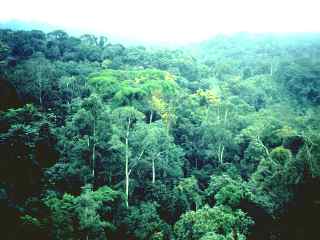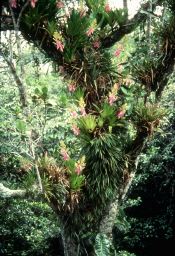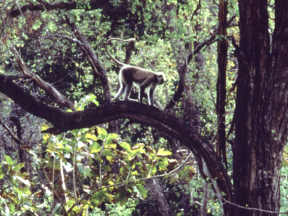|
The Forest BiomeThe forest biome consists of close growing trees with leaf canopies that generally overlap. Much sunlight can be prevented from reaching the forest floor if tree limbs and foliage tightly intermingle. The lack of sunlight inhibits the development of undergrowth, creating an open forest structure. If the canopy is open, sunlight can reach the forest floor and promote the development of undergrowth resulting in a closed forest structure. Forests require ample amounts of annual precipitation to support their growth. The shaded conditions of the closed forest keep soils relatively moist. Forests are
found over a wide range of temperature regimes
The Tropical Rain forestThe Tropical Rain forest contains trees standing 30 to 55 meters in height, creating a continuous canopy of foliage. The enclosed canopy shades the forest floor, creating an open forest formation. Few pure stands of trees exist in the rain forest. Instead, individual trees are widely dispersed throughout the forest. Mahogany, teak and other tropical hardwoods are harvested for creating fine furniture. The lush vegetation and great animal diversity should be expected in the tropical rain forest climate.
Figure 13.2 The multistory canopy of the tropical rain forest (Congo) (Image courtesy FAO) Peering into the canopy reveals a multistory appearance of broad leaf, evergreen vegetation called "selva". The typical three-tiered zonation includes an emergent layer of solitary, giant trees reaching heights of 55 meters (180 ft) for the sunlight they require. Beneath is an intermediate zone (canopy) of continuous foliage 9 to 18 meters (30 to 60 ft) high. The forest floor is relatively open as the shade of the closed canopy inhibits plant growth. It is a damp and dim world as one walks through the aroma of decaying vegetation. Giant woody vines called "lianas" snake their way up the trunks of trees. Epiphytes ("air plants"), like the brilliantly colored bromeliad, grow in the hollows of trees or the upper surfaces of horizontally-growing branches capturing nutrients and moisture from the air.
Figure 13.3 Bromeliads clinging to a rain forest tree (Image courtesy FAO) A cloud forest exists on extremely moist mountain slopes above the elevation of the true rain forest. The cloud forest differs from the rain forest found at lower elevations in that trees are much shorter and the forest floor is virtually impenetrable. Plants have adapted to this environment in unique ways:
The rain forest is a treasure trove of different animal and plant species. The numerous species that inhabit the rain forests are not well documented. The intense precipitation of the tropical rain forest climate heavily leaches the soil. Oxisol soil common to the rain forest is relatively infertile due to intense weathering and a lack of available nutrients. Deforestation and habitat destruction is severely crippling the rain forest ecosystem. View the "Secret Life of the Rainforest" provided by the Smithsonian Channel.
|


